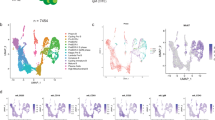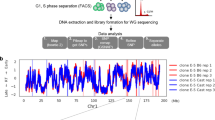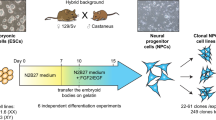Abstract
The developmental control genes of the Pax family are frequently associated with mouse mutants and human disease syndromes1,2,3. The function of these transcription factors is sensitive to gene dosage, as mutation of one allele1,2,3 or a modest increase in gene number4 results in phenotypic abnormalities. Pax5 has an important role in B-cell and midbrain development5,6,7. By following the expression of individual Pax5 alleles at the single-cell level, we demonstrate here that Pax5 is subject to allele-specific regulation during B-lymphopoiesis. Pax5 is predominantly transcribed from only one allele in early progenitors and mature B cells, whereas it switches to a biallelic transcription mode in immature B cells. The allele-specific regulation of Pax5 is stochastic, reversible, independent of parental origin and correlates with synchronous replication, in contrast with imprinted8,9 and other monoallelically expressed genes10,11. As a consequence, B-lymphoid tissues are mosaics with respect to the transcribed Pax5 allele, and thus mutation of one allele in heterozygous mice results in deletion of the cell population expressing the mutant allele due to loss of Pax5 function at the single-cell level. Similar allele-specific regulation may be a common mechanism causing the haploinsufficiency and frequent association of other Pax genes with human disease.
This is a preview of subscription content, access via your institution
Access options
Subscribe to this journal
Receive 12 print issues and online access
$209.00 per year
only $17.42 per issue
Buy this article
- Purchase on Springer Link
- Instant access to full article PDF
Prices may be subject to local taxes which are calculated during checkout





Similar content being viewed by others
References
Strachan, T. & Read, A.P. PAX genes. Curr. Opin. Genet. Dev. 4, 427–438 ( 1994).
Sanyanusin, P. et al. Mutation of the PAX2 gene in a family with optic nerve colombomas, renal anomalies and vesicoureteral reflux. Nature Genet. 9, 358–364 ( 1995).
Macchia, P.E. et al. PAX8 mutations associated with congenital hypothyroidism caused by thyroid dysgenesis. Nature Genet. 19, 83–86 (1998).
Schedl, A. et al. Influence of PAX6 gene dosage on development: overexpression causes severe eye abnormalities. Cell 86, 71–82 (1996).
Urbánek, P., Wang, Z.-Q., Fetka, I., Wagner, E.F. & Busslinger, M. Complete block of early B cell differentiation and altered patterning of the posterior midbrain in mice lacking Pax5/BSAP. Cell 79, 901–912 ( 1994).
Nutt, S.L., Urbánek, P., Rolink, A. & Busslinger, M. Essential functions of Pax5 (BSAP) in pro-B cell development: difference between fetal and adult B lymphopoiesis and reduced V-to-DJ recombination at the IgH locus. Genes Dev. 11, 476–491 (1997).
Nutt, S.L., Morrison, A.M., Dörfler, P., Rolink, A. & Busslinger, M. Identification of BSAP (Pax-5) target genes in early B-cell development by loss- and gain-of-function experiments. EMBO J. 17, 2319–2333 (1998).
Barlow, D.P. Gametic imprinting in mammals. Science 270, 1610–1613 (1995).
Surani, M.A. Imprinting and the initiation of gene silencing in the germ line. Cell 93, 309–312 ( 1998).
Chess, A., Simon, I., Cedar, H. & Axel, R. Allelic inactivation regulates olfactory receptor gene expression. Cell 78, 823–834 (1994).
Holländer, G.A. et al. Monoallelic expression of the interleukin-2 locus. Science 279, 2118–2121 ( 1998).
Nolan, G.P., Fiering, S., Nicolas, J.-F. & Herzenberg, L.A. Fluorescence-activated cell analysis and sorting of viable mammmalian cells based on β-D-galactosidase activity after transduction of Escherichia coli lac-Z. Proc. Natl Acad. Sci. USA 85, 2603–2607 (1988).
Rolink, A.G., Andersson, J. & Melchers, F. Characterization of immature B cells by a novel monoclonal antibody, by turnover and by mitogen reactivity. Eur. J. Immunol. 28, 3738–3748 ( 1998).
Busslinger, M., Klix, N., Pfeffer, P., Graninger, P.G. & Kozmik, Z. Deregulation of PAX-5 by translocation of the Eμ enhancer of the IgH locus adjacent to two alternative PAX-5 promoters in a diffuse large-cell lymphoma. Proc. Natl Acad. Sci. USA 93, 6129–6134 ( 1996).
Panning, B. & Jaenisch, R. RNA and the epigenetic regulation of X chromosome inactivation. Cell 93, 305 –308 (1998).
Held, W., Roland, J. & Raulet, D.H. Allelic exclusion of Ly49-family genes encoding class I MHC-specific receptors on NK cells. Nature 376, 355–358 (1995).
Held, W. & Kunz, B. An allele-specific, stochastic gene expression process controls the expression of multiple Ly49 family genes and generates a diverse, MHC-specific NK cell receptor repertoire. Eur. J. Immunol. 28, 2407–2416 (1998).
Bix, N. & Locksley, R.M. Independent and epigenetic regulation of the interleukin-4 alleles in CD4+ T cells. Science 281, 1352–1354 ( 1998).
Rivière, I., Sunshine, M.J. & Littman, D.R. Regulation of IL-4 expression by activation of individual alleles. Immunity 9, 217– 228 (1998).
Kitsberg, D. et al. Allele-specific replication timing of imprinted gene regions. Nature 364, 459–463 (1993).
Knoll, J.H.M., Cheng, S.-D. & Lalande, M. Allele specificity of DNA replication timing in the Angelman/Prader-Willi syndrome imprinted chromosomal region. Nature Genet. 6, 41–46 ( 1994).
Panning, B. & Jaenisch, R. DNA hypomethylation can activate Xist expression and silence X-linked genes. Genes Dev. 10, 1991–2002 (1996).
Adams, B. et al. Pax-5 encodes the transcription factor BSAP and is expressed in B lymphocytes, the developing CNS, and adult testis. Genes Dev. 6, 1589–1607 ( 1992).
Georgopoulos, K. et al. The Ikaros gene is required for the development of all lymphoid lineages. Cell 79, 143– 156 (1994).
Forejt, J. & Gregorová, S. Genetic analysis of genomic imprinting: an imprintor-1 gene controls inactivation of the paternal copy of the mouse Tme locus. Cell 70, 443–450 (1992).
Stöger, R. et al. Maternal-specific methylation of the imprinted mouse Igf2r locus identifies the expressed locus as carrying the imprinting signal. Cell 73, 61–71 (1993).
Smrzka, O.W. et al. Conservation of a maternal-specific methylation signal at the human IGF2R locus. Hum. Mol. Genet. 4, 1945–1952 (1995).
Ghia, P. et al. Ordering of human bone marrow B lymphocyte precursors by single-cell polymerase chain reaction analyses of the rearrangement status of the immunoglobulin H and L chain gene loci. J. Exp. Med. 184, 2217–2229 (1996).
Rolink, A. et al. A subpopulation of B220+ cells in murine bone marrow does not express CD19 and contains natural killer cell progenitors. J. Exp. Med. 183, 187– 194 (1996).
Zhou, L.-J., Ord, D.C., Hughes, A.L. & Tedder, T.F. Structure and domain organization of the CD19 antigen of human, mouse, and guinea pig B lymphocytes. J. Immunol. 147, 1424– 1432 (1991).
Acknowledgements
We thank K. Georgopoulos and D. Barlow for plasmids, B. Panning for advice on RNA-FISH and J. Forejt for PWD mice. This work was partly financed by the Austrian Industrial Research Promotion Fund. Z.K. was supported by GACR (grant no. 204/96/0014).
Author information
Authors and Affiliations
Corresponding author
Rights and permissions
About this article
Cite this article
Nutt, S., Vambrie, S., Steinlein, P. et al. Independent regulation of the two Pax5 alleles during B-cell development . Nat Genet 21, 390–395 (1999). https://doi.org/10.1038/7720
Received:
Accepted:
Issue Date:
DOI: https://doi.org/10.1038/7720
This article is cited by
-
Analysis of allelic expression patterns in clonal somatic cells by single-cell RNA–seq
Nature Genetics (2016)
-
Random monoallelic expression of autosomal genes: stochastic transcription and allele-level regulation
Nature Reviews Genetics (2015)
-
B-lineage transcription factors and cooperating gene lesions required for leukemia development
Leukemia (2013)
-
Analysis of allele-specific RNA transcription in FSHD by RNA-DNA FISH in single myonuclei
European Journal of Human Genetics (2010)
-
Successful elimination of non-neural cells and unachievable elimination of glial cells by means of commonly used cell culture manipulations during differentiation of GFAP and SOX2 positive neural progenitors (NHA) to neuronal cells
BMC Biotechnology (2008)



